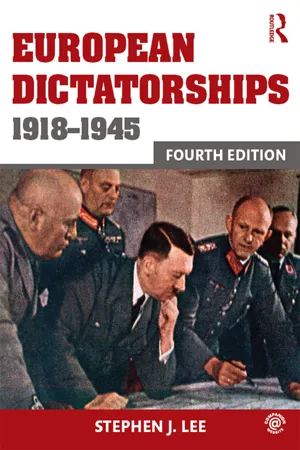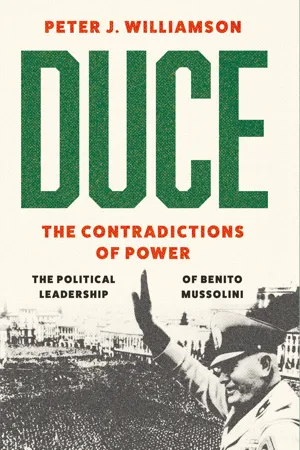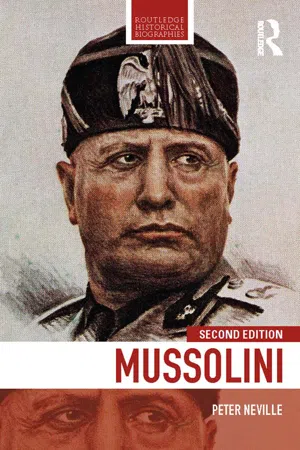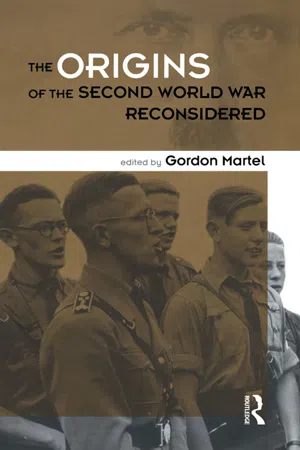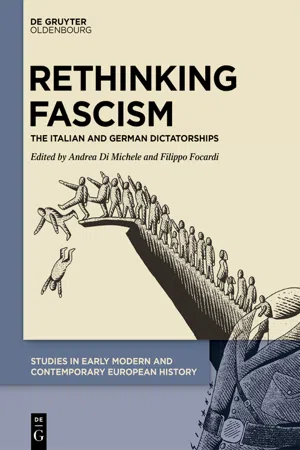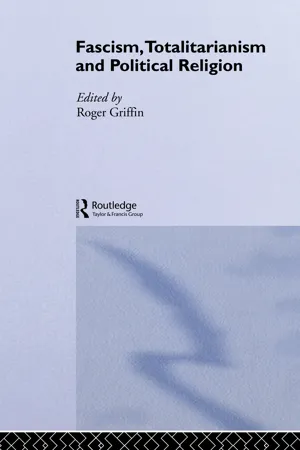History
Mussolini
Mussolini, also known as Benito Mussolini, was an Italian politician and leader of the National Fascist Party. He served as Prime Minister from 1922 to 1943, establishing a fascist dictatorship and allying with Nazi Germany during World War II. His rule was characterized by authoritarianism, censorship, and aggressive foreign policies, ultimately leading to his downfall and execution in 1945.
Written by Perlego with AI-assistance
10 Key excerpts on "Mussolini"
- eBook - ePub
- Stephen J. Lee(Author)
- 2016(Publication Date)
- Routledge(Publisher)
The problem was that the regime needed a more obvious appearance of success. Mussolini sought this in a more active foreign policy, which involved his dictator ship in a series of wars. This meant another round of radical changes in the late 1930s; these were the result partly of domestic pressures and partly of influences from Nazi Germany. The result was, in Morgan’s words, that ‘Between 1936 and 1940 the regime consciously stepped up and intensified its attempts to “fascistise” Italian society.’ 25 This broke the earlier balance and consensus within Italy and meant the intensification of repression on the one hand and of opposition on the other. 4 Benito Mussolini, photo taken in 1923 (© Hulton Archive/Getty) Meanwhile, Italy’s economic infrastructure, seriously weakened between 1936 and 1939 by constant exposure to war, was tested to the point of collapse by Mussolini’s disastrous decision to enter the Second World War. Although Mussolini attempted between 1943 and 1945 to recreate something of the original dynamism of Fascism, by this time he had become no more than a Nazi puppet within a small part of northern Italy. The ideology of Fascism In 1932 Mussolini penned the basic ideas of the movement, clearly and emphatically, in his Political and Social Doctrine of Fascism. Fascism, he said, was anti-communist, anti-socialist and strongly opposed to an economic conception of history. He denied that class war can be the preponderant force in the transformation of society. Fascism was also anti-democratic, denouncing the whole complex system of democratic ideology. It was certainly authoritarian: ‘The foundation of Fascism is the conception of the State - eBook - ePub
Duce: The Contradictions of Power
The Political Leadership of Benito Mussolini
- Peter J. Williamson(Author)
- 2023(Publication Date)
- Hurst Publishers(Publisher)
35 What was in relatively short supply was a deep political identification with Mussolini’s radical Fascism, if for no other reason than it was modulated in promoting his personal cult. Looking back after he fell from power he would, as seen earlier, come to question some of the bases of appeal upon which his Fascism was advanced, although Italians in general were held to be essentially culpable. He never sought to reflect upon the contradiction that, while he sought to build a national community, his regime to a considerable extent rested upon responding to particular sectional interests and not others. His intention to build a national community was therefore far from solidly based.Some historians regard studies of Mussolini to have exaggerated his influence over what happened during the ventennio at the expense of that of the Fascist movement. Certainly, it is important not simply to lay all that occurred at the door of the Duce. Mussolini sought a legal revolution that left many institutions intact or at least surviving from Liberal Italy. Likewise, many of his economic and social policies can trace their origins and thinking to the pre-1922 period. That said, Mussolini’s rule marked a definite reversal in the broad trend in the twentieth century of democratic and social progress in Italy. His rule entailed the end of any parliamentary government, the creation of a pervasive police state and curtailment of civil liberties, the suppression of the political and industrial organisational power of the working class, a stricter regimentation of society, and ultimately a far more aggressively expansionist foreign policy. Without the cataclysmic wartime and postwar dislocation and strife in 1914–22 it is impossible to imagine the conditions existing for Fascism to come to power then. The earlier inability of Prime Minister Giolitti to secure sufficient support for a coalition around democratic reform, the growing ineffectiveness of the Liberal state, the view of employers (especially landowners) that the state should essentially be their protector, a virulent and prevalent hostility to socialism and the rise of a militant if unrealistic nationalism all set an important context for the rise of Fascism and hence of Mussolini.36The Fascists, with Mussolini at the head, were able to ride and ferment these circumstances in rising to power, doing much to set the tenor of the ventennio. If Fascism marked important breaks with the past, outside the comparatively small core of ardent Fascists, those who variously supported his regime displayed considerable self-interest in protecting and expanding private power. Those people and institutions with power did on the one hand sustain Mussolini’s authoritarian, repressive and elitist rule, but on the other guaranteed that the regime had a notably conservative, technocratic and privately acquisitive (not to say corrupt) nature. The Fascist state enabled private power to pursue interests at variance with the ideas of national regeneration for something more prosaic. Acquisitiveness was endorsed by Mussolini. In one of the many contradictory features of his leadership, he saw private wealth as one of the glues to keep party and other leaders on the side of his regime, which claimed solely to be motivated by the collective national interest. Many Fascist leaders became very rich under the regime.37 - No longer available |Learn more
The Modernization of the Western World
A Society Transformed
- John McGrath, Kathleen Callanan Martin(Authors)
- 2017(Publication Date)
- Routledge(Publisher)
As Mussolini put it in his efforts to further define fascism: “Everything in the state, nothing against the state, nothing outside the state.” 3 In order to legitimize his use of power Mussolini turned to the philosopher Giovanni Gentile to provide him with an ideology of fascism. Gentile wrote up the definition, which was widely published as Mussolini’s own philosophy. What emerged was an eclectic and jumbled mix of ideas from a variety of sources, including Hegel, Nietzsche, Sorel, Treitschke and a number of other idealist writers who celebrated anti-rational impulses. Fascism glorified the use of force and war as the noblest of human activities, and it denounced liberalism, capitalism, democracy, socialism, and communism. Most significantly fascism deified the state as the supreme embodiment of the human spirit. The English writer G. K. Chesterton said that fascism was nationalism gone mad. In 1925 Mussolini undertook an agreement with Italian industrialists and bankers that gave them privileges in return for supporting the Fascist Party. This partnership, which Mussolini called “corporativism,” was presented as the vehicle for ending class conflict. In reality, the arrangement simply assured the dominance of capitalism and the control of labor and professional groups. The so-called corporativist economic structure was to eliminate the free market and, through planning and management, reallocate resources for maximal efficiency. In practice corporativism was nothing more than a rhetorical mask to hide the creation of a command economy under the control of government and big business. Trade unions were abolished, except those controlled by Fascists. State propaganda went into high gear. Images of Mussolini were posted throughout the country; radio and films depicted him as “Il Duce,” or “the leader.” Although Mussolini was himself an atheist, he saw the necessity of cultivating the support of the Catholic Church - 21 And Italian Fascism was not merely anti-Communist but also an enemy of parliamentary democracy, trade unionism and indeed pluralism in Italian society. Anything which did not accord with the narrowly Fascist definition of Italian-ness was to be destroyed.A major caveat has to be entered at this point. It is that, in achieving power, Mussolini had to make compromises with those very forces his more radical followers despised. In the Italian context, this meant the monarchy, the Church and the army, without whose tacit approval or passivity the Fascists could not have come to power in October 1922. As has been seen, the Fascist deputies in the Chamber dropped their anti-clericalism to win Church approval just as Mussolini wooed both king and army in the weeks before he came to power. It can, of course, be argued that Mussolini was obliged to make deals to secure power, but the fact remains that these rival conservative power centres remained in play in Italy all through the Fascist era. Thus, Mussolini may have sought to achieve national rebirth in Italy after 1922, but there must be serious questions about the extent to which he achieved a Fascist revolution, and if indeed this was ever going to be possible. Fascism, therefore, can be deemed to be revolutionary only in the sense that it did involve a rejection of the liberal democracy which had come into existence in 1870. This liberal democracy was, in fact, to be destroyed when Mussolini introduced his personal dictatorship in 1925. Thereafter, there are good grounds for saying that Mussolini still never resolved the tensions between his genuinely radical followers and the needs of the Italian State. He recognised these tensions in his very first government by keeping leading Fascist radicals out of office. His struggle to resolve them forms the focus for succeeding chapters. In the meantime, Mussolini was content to act as a mediator between the Fascist Party and its non-Fascist political supporters, such as the industrialists and big landowners.
- eBook - ePub
- Gordon Martel(Author)
- 2002(Publication Date)
- Routledge(Publisher)
After Italy’s entry into war in 1940, Winston Churchill singled out Benito Mussolini as the “one man and one man only [who] was resolved to plunge Italy…into the whirlpool of war.” 5 Although at the time no more than a propaganda ploy to divide the Fascist Duce from the Italian people, it epitomized the view that Italy’s recent belligerence could be laid exclusively at the door of the Fascist regime. After the war some Italians built on this idea to develop the “parenthesis” argument, namely, that Fascism was a disjunctive interlude in the “real history” of united Italy. Fascism, wrote Benedetto Croce, the most notable spokesman of this persuasion, “was an outgrowth extraneous to Italy’s long history and repugnant to recent Italian traditions.” 6 Over the past half-century this assertion has been increasingly challenged, even if one cannot isolate any clear-cut historiographical watershed equivalent to the Fischer–Taylor revisionism in the case of Germany. In Italy, opinion changed more gradually, but nonetheless in the same direction and for the same purpose as in German historical writing – to situate the Fascist experience in the longue durée of Italian history. And, as in the German paradigm, the most pertinent link between liberal and Fascist Italy is to be found in the pursuit of national grandezza – a position which has been argued most forcefully by Richard Bosworth in a series of publications. 7 This was deducible, in fact, as early as 1951 with the publication of Federico Chabod’s sophisticated analysis of Italian foreign policy towards the end of the nineteenth century. 8 Chabod drew attention to the legacy of the risorgimento, the renewal of Italian culture that underpinned the drive for the peninsula’s political unification - eBook - ePub
Rethinking Fascism
The Italian and German Dictatorships
- Di Michele Andrea, Filippo Focardi, Andrea Di Michele, Filippo Focardi(Authors)
- 2022(Publication Date)
- De Gruyter Oldenbourg(Publisher)
83 . It was doubtless less stressful to do so.The many curiosities of Mussolini’s personal rule can be charted. But it is also possible to find structural features of his regime that, in the 2020s, can be read in a novel fashion and which demonstrate that even a modern dictator does not have complete free will. Cliché says that he was the first dictator in modern European history, the first fascist and the first totalitarian. But should we now also ask whether, notably in the second decade of his regime, he was also the first populist?It may readily be agreed that the Duce by 1932 had won considerable admiration inside and outside Italy. Marxists knew that Mussolini was the murderer of Matteotti and his “fascism” was an international doctrine that expressed bourgeois rule at its most violent and cruel. Other observers were more positive. In a memorable series of interviews in the Spring of 1932, Emil Ludwig, fellow celebrity-journalist and biographer of Frederick II, Napoleon, Lincoln, Wilson, Rhodes, Bismarck and the Kaiser, Leonardo Da Vinci, and Machiavelli, found the Duce to be a master of detail, “in conversation, […] the most natural man in the world”, a “great statesman”84 . Pressed to define his ideology and its place in the world, Mussolini was decidedly modest. “When, recently, a Finnish thinker asked me to expound to him the significance of fascism in a single sentence”, “I wrote: ‘Life must not be taken easily’”. It might contain elements “which other countries might adopt”, he agreed85 . But his people, from classical times on, had been ruled by many dictators and, in fact, his regime might well be “Italian specific”.The massive weight of the literature seeking to define fascism is hard to set aside. But, for the moment, let me try to do so. In 1932, Italian commentary about the dictatorship was doubtless fulsome and, like Mussolini, was perpetually tempted to find parallels and imitators elsewhere. Yet it was scarcely focused in the fashion that has become dominant among the many worthy scholars devoted to interpreting fascism as a global ideology spread, like coronavirus from Italy. The prominent journalist, Asvero Gravelli, was only one to find links with the Lapua Movement in Finland, the “Blue Shirts” of Oliver Locker-Lampson in the U.K., helped by Harold “Eoad” (Goad: the director of the British cultural institute in Florence), both the Sthalhelm [sic] in Germany (Gravelli made frequent mistakes in inscribing foreign names), and the Nazis, although Gravelli maintained Italians were “the Protestants of the racist religion”. Other links to Italy, he thought, could be located from Spain to Brazil, certainly embraced Kemal Atarürk in Turkey and might well include F. D. Roosevelt in the USA86 - eBook - ePub
- Roger Griffin, Roger Griffin(Authors)
- 2013(Publication Date)
- Routledge(Publisher)
To reduce Fascism to ‘Mussolinism’ is to trivialise the problem of the ‘Leader’ in the totalitarian system. It not only overlooks the existence and behaviour of the organisation, but also does not take into consideration the fact that without the Fascist organisation, the myth of the Duce and the figure himself would have been incomprehensible. Finally, without going into the merits of the debate on the theoretical placing of Italian Fascism within the models of totalitarianism elaborated by the social sciences, one can note that there has been a Fascist conception of totalitarianism, and this cannot be overlooked. Once one attributes a ‘totalitarian tendency’ to Fascism, which distinguishes it from traditional authoritarian regimes, one then has to study how this tendency originated, how it was formed in reality, and how it operated to modify reality, conditioning the lives of millions of men and women in the process. The failure of fascist totalitarianism is not a proof of its non-existence. The gap between myth and achievement is not an argument against the importance of myths in the politics of Fascism, nor against its conception and mode of organisation of the masses. 51 Fascism was the ‘Italian way to totalitarianism’. Fascist totalitarianism represented a reality in a continuous process of construction which unfolded progressively, taking shape in political culture, education and in the lifestyle of the Fascist regime by means of a complex relationship between the ideology, party and regime which, despite contrasts and contradictions, shows the constant presence of a totalitarian logic peculiar to Fascism, present in both the ideology and the political actions of the Fascist movement/regime. Obviously, the Fascist totalitarian experiment in the course of its implementation encountered numerous obstacles in society: for example, in the apparatus of the old State, and in the Church - eBook - ePub
- John Pollard(Author)
- 2005(Publication Date)
- Routledge(Publisher)
9 The legacy of Italian FascismIntroduction
Italian Fascism did not suddenly appear from nowhere. Its origins were deeply rooted in certain intellectual, social and political developments in the decades preceding the First World War, and there were many continuities between the Fascist regime and the Liberal state which it had displaced. It is also true that Fascism did not suddenly and finally disappear in 1945 without leaving any traces. On the contrary, it left behind a powerful legacy which ensured strong continuities between the Fascist regime and the democratic republic of the postwar period. Insofar as Fascism failed to solve the major economic, social and political problems facing Italy, there are even continuities between the pre-Fascist Liberal regime and the democratic republic. Indeed, according to the Marxist historian, Paolo Spriano, the legacy of Fascism conditioned, ‘the entire life of the [Italian] nation’ (Duggan and Wagstaff, 1995, p. 9). This is certainly overstating the case, but even allowing for other powerful factors—such as the Cold War and the consequent fear of Communism in Italy, the economic ‘miracle’ of the 1950s and 1960s and the massive social changes which it brought, and the American cultural ‘invasion’ from the 1950s onwards—much of Italy’s development as a modem, democratic, capitalist state in the post-war period has been shaped by the legacy of Fascism. It has also become evident in the last few years that the Fascist legacy still has a potentially important role to play in shaping Italy’s future.Foreign Policy and National identity
As we have seen, Fascism’s foreign adventures in the Second World War ended in disastrous failures with the result that in the international political sphere Italy effectively ceased to exist as an independent entity: just as Mussolini’s Republic of Salo was essentially a Nazi puppet state, so the King’s government in the South was a client of the Allies. Though the Allies formally recognised Italy as a ‘co-belligerent’ in the war against Germany after the armistice of September 1943, in practice the Italian government had little real power as opposed to the authority of A.M.G. (Allied Military Government of Italy). Italy was not to recover her international autonomy until the peace treaty was signed with the Allies in February 1947. As a result of that agreement, Italy lost most of her colonial empire, had to pay reparations to the countries against whom she had fought (including Russia), her armed forces were reduced in size and she lost territory on both her western and eastern borders. - eBook - ePub
Rethinking Geographical Explorations in Extreme Environments
From the Arctic to the Mountaintops
- Marco Armiero, Roberta Biasillo, Stefano Morosini(Authors)
- 2022(Publication Date)
- Routledge(Publisher)
28Roberto Ducci, in an article written five years later, summed up the shift from the transformation of the nation to nation’s rebirth abroad. According to Ducci, once fascism had restored the authority of the state within the nation, it was time to look beyond the national borders.29 As journalist Giorgio Pini noted in the early 1930s, “what is needed is to contribute to the formation of a clear Italian international conscience because the scope of the Italian fascist struggle is now shifting from inside to outside”.30Hence, as historian Pietro Pastorelli has argued, 1928 was also a remarkable year in terms of the revision of the Italian foreign policy31 with the revival of the myth of the ‘Third Rome’ so beloved by pre-war nationalists. Two books published in 1928 were emblematic of this new global ambition: the one written by the idealist and traditionalist philosopher Antonio Bruers on “Italy’s world mission”32 and the collection of speeches and writing of Pietro Foscari, cofounder of the nationalist association in 1910 and enthusiastic supporter of Italian colonialism.33My argument is that this new diplomatic orientation led to full support for competitive sporting and scientific exploration initiatives. Although not always directly connected to colonial ambitions, the Italian explorations of those years were nonetheless expressions of the new fascist nation and its renewed energies. Clearly neither the Karakorum nor, to an even greater extent, the Arctic fitted into fascist Italy’s geopolitical spheres of action, which were limited to the Mediterranean, dominated by the mare nostrum ideal and for the most part projected towards the Danube. There were, though, pushes towards a more global sphere of action for the fascist regime. Giorgio Pini, journalist and biographer of Mussolini, argued that the “international struggle” of fascism could in no way be constrained geographically, at least eastwards. According to Pini, only a fascist Rome, with its historical legacy of a truly global empire, could “show the way and march into the future”.34 And more: “The Italian Fascist echo, which has already made its way into the darkest recesses of the world, is also making itself repeatedly felt in distant Asia”.35 - eBook - ePub
- Philip Morgan(Author)
- 2003(Publication Date)
- Routledge(Publisher)
The dynamic of both fascist totalitarian regimes came from the interaction of domestic and foreign policies, the internal preparation for imperialist wars of conquest and expansion. Nazi Germany's racial empire lay to the East, in Eastern Europe and Western Russia, the ‘living space’ to be conquered and colonised so as to ensure the survival and dominance of the German race. Fascist Italy's ‘living space’, another ‘Roman’ empire to make the country independent and powerful, was in and around the Mediterranean. Empires of such dimensions, which involved the disappearance of many existing states and empires, could not be achieved by diplomacy, only by war. The necessary premise for successful wars of empire was national strength and unity, the fascistisation of their peoples. The end was war, for conquest; the means was also war, against their own societies, to make them warlike and war-ready. Fascistisation made war possible, and would itself be strengthened and accelerated through and by war.This is the fascist totalitarian dynamic stripped to its essentials, and tidied up. Real life, things, people, were refractory material, not so easily nor so tidily bent to the fascist will. But it is not distorting what actually happened in Fascist Italy and Nazi Germany in the 1930s, to say that there was a discernible synchronisation of domestic and foreign policies, a progressive and mutually reinforcing radicalisation of both, as more assertive and aggressive foreign policies were matched by an intensified fascistisation internally. The effect of this cumulative radicalisation was that both regimes broke through the crust of compromise with established elites and institutions, and the ‘new order’ began to supplant and supersede the ‘old’. The shift was evident in both countries between 1936 and 1938.Opportunely for such an analysis, the development of the Fascist regime in Italy turned on the most fascist of projects, war: the invasion and conquest of Ethiopia in East Africa, in 1935–36. In diplomatic terms, Hitler's coming to power in Germany gave Mussolini the opening to put into effect invasion plans drawn up in the Colonial Ministry by 1932. A relatively small power in European and global terms, Italy could not really go it alone, internationally. But Italy could operate in the space between stronger powers contesting European hegemony. The attempted Nazi coup in Austria made the threat of Anschluss immediate, and helped to push Mussolini towards a tacit deal with France early in 1935. If Italy would help France prevent Anschluss and contain German revisionism in Central and Eastern Europe, then France would allow Italy to have its way in East Africa.There was a continuity of policy here with pre-Fascist liberal Italy, not only in Italy's smaller power exploitation of the rivalries between more powerful countries, but also in the chosen area of expansion. Italy already had small colonies in East Africa, Eritrea and Somalia, and the 1935 attack was the opportunity to avenge the national humiliation of Ethiopia's defeat of an Italian army in 1896. The continuity with the colonial aspirations of the recent past helped to explain the support of Italy's establishment for Mussolini's policy.
Index pages curate the most relevant extracts from our library of academic textbooks. They’ve been created using an in-house natural language model (NLM), each adding context and meaning to key research topics.
Explore more topic indexes
Explore more topic indexes
1 of 6
Explore more topic indexes
1 of 4
